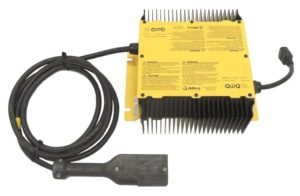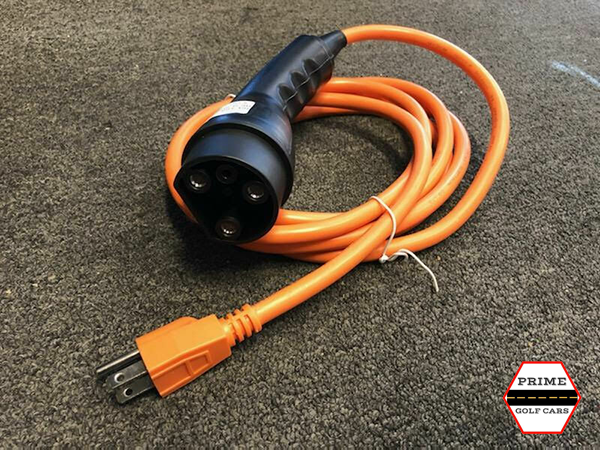Golf cart battery charging, in reference to standard lead-acid golf cart batteries, isn’t always as simple as just plugging the cart in or periodically refilling the water levels of the batteries. However, optimizing the performance and getting the most life out of the battery as possible can require additional steps to make sure that the batteries are functioning the absolute best they can.
 Batteries in an Advanced EV golf cart with an onboard charger |
 Batteries in an EZGO golf cart without an onboard charger |
Golf Cart Battery Charging Algorithm
 Most golf cart chargers use a 3-stage charging algorithm, consisting of a bulk charge stage, absorption charge stage, and finish charge stage. This algorithm determines how much power returns to the battery at various intervals, in order to make sure it is not undercharged or overcharged. During the bulk charge stage, about 80% of the discharged battery power will be recharged, usually taking around 4-8 hours depending on how low the battery charge was. The second stage, the absorption charge stage, the charge current slowly decreases until the 100% of the discharged battery power is recharged – however, this does not mean the battery is fully recharged. The final stage, the finish charge stage, slightly and safely overcharges the battery to account for efficiency losses. When using the right size charger, the battery is safely overcharged without damage.
Most golf cart chargers use a 3-stage charging algorithm, consisting of a bulk charge stage, absorption charge stage, and finish charge stage. This algorithm determines how much power returns to the battery at various intervals, in order to make sure it is not undercharged or overcharged. During the bulk charge stage, about 80% of the discharged battery power will be recharged, usually taking around 4-8 hours depending on how low the battery charge was. The second stage, the absorption charge stage, the charge current slowly decreases until the 100% of the discharged battery power is recharged – however, this does not mean the battery is fully recharged. The final stage, the finish charge stage, slightly and safely overcharges the battery to account for efficiency losses. When using the right size charger, the battery is safely overcharged without damage.
In order to fully optimize the performance and life of lead-acid batteries, it’s recommended that the properly sized charger for the amp-hour (AH) capacity is used. The bulk charge stage of the charging algorithm should have a charge current of approximately 10% of the 20 hour capacity of the batteries, and the finish charge stage should have a charge current of about 3% of the 20 hour capacity of the batteries. The 20 hour capacity can be found on the battery’s sticker.
The voltage output of the charger should be sized to the number of cells connected in series in the battery pack. You find this by taking the number of cells connected in series times 2 volts per cell. A battery pack with 24 cells connected in series will use a 48 volt charger. The charger should also be able to provide an on-charge voltage of at least 2.6 volts per cell. A 48 volt charger for a 48 volt battery pack, therefore, should be able to provide at least 62.4 volts on a charge in order to completely charge the battery pack.
Depth of Discharge Meaning
When reading about lead-acid batteries, you may come across the term “depth of discharge”, or DOD. Simply put, the DOD refers to how much energy is cycled into and out of the battery on a given cycle, and is expressed as a percentage of the total capacity of the battery. For example, a battery that has been drained by 30% has a 30% DOD, and 70% of its capacity remains. It’s important to understand DOD because the more frequently a lead-acid battery is discharged and recharged, the shorter its lifespan will be. When the battery percentage gets down very low and is then recharged, this can shorten the life of the battery as well. To help with this, many battery companies recommend a 50% DOD. We have more on our 50% charging recommendation for our rental carts further down below.
Golf Cart Battery Charging Tips
 When charging lead-acid golf cart batteries, it’s important to do it in a well-ventilated area. One of our recommendations is also to lift up the seat that covers the batteries – in 4 passenger carts, they are most often under the front 2 seats, and 6 passenger carts mostly have them under the middle row of seats – either before or directly after plugging in the charger. This is because when a lead-acid battery system is plugged in, as it begins charging, it can release hazardous fumes from the chemicals inside the batteries. Build-up of these fumes under the seats can be dangerous, so to avoid this, either leave the seat up as the batteries charge, or lift the seat and allow any possible fumes to clear out and ventilate before putting the seat back down.
When charging lead-acid golf cart batteries, it’s important to do it in a well-ventilated area. One of our recommendations is also to lift up the seat that covers the batteries – in 4 passenger carts, they are most often under the front 2 seats, and 6 passenger carts mostly have them under the middle row of seats – either before or directly after plugging in the charger. This is because when a lead-acid battery system is plugged in, as it begins charging, it can release hazardous fumes from the chemicals inside the batteries. Build-up of these fumes under the seats can be dangerous, so to avoid this, either leave the seat up as the batteries charge, or lift the seat and allow any possible fumes to clear out and ventilate before putting the seat back down.
Charge batteries as soon as possible after discharging. As a golf cart sits idle, even if it’s not on, the batteries will slowly lose charge, just like your phone might when it sits for a while without charging. Therefore, to keep your batteries charged and possibly increase their life cycles, plug in the cart after use and make sure to unplug the charger once it’s fully charged. Use the right sized charger to prevent overcharging as well. Check your electrolyte levels monthly and keep your batteries filled – use distilled or deionized water and cover the plates before charging, but don’t fully refill the batteries until after they are done charging to prevent overflow.
If storing your golf cart longer than a month, fully charge the batteries prior to storage. We have another blog with more on golf cart long-term self-storage, with additional tips for storing your golf cart on your own property.
Our 50% Golf Cart Battery Charging Recommendation
When renting one of our street legal golf carts, we always recommend that customers charge the batteries when the cart starts to get to around a 50% charge. Generally, during rentals, people use the carts during the day and plug them in overnight, and if the battery percentage doesn’t drop too low, most of the time the cart is fully charged by the next morning. When lead-acid batteries get too low, they take a much longer time to recharge back to 100% – depending on the cart, some lead-acid batteries can take up to 16 hours to fully recharge if the batteries were run down too low. Some carts, mostly older ones, won’t even respond to a regular golf cart charger if the battery is too low, and need to be supercharged – similar to jumping a car – before they can be plugged in to a standard charger. If the battery percentage is kept monitored and does not drop too far below 50%, the batteries will most often take about 6-8 hours to fully recharge. This is why we recommend plugging the cart in at night.
NOTE: Watch for Surface Charge
Sometimes, you may plug in a golf cart and after only a couple hours, the state of charge meter may say the cart is 100% charged. However, this is only a surface charge, meaning that it appears that the batteries are fully charged, but have not had a chance to deeply absorb all the power that they need. This cart will drive for a short time with regular battery charge decay, then suddenly begin to drop more rapidly if the battery has only had this beginning charging stage. To make sure the battery is fully charged: in our Advanced EV carts, the onboard Eagle charger will have a fan that comes on when the cart is plugged in, and when completely, deeply recharged, the fan will shut off. For carts that don’t have an onboard charger with indicators such as this, the charger will often give an indication with a light that the golf cart is fully recharged. NOTE: Not all chargers or carts make a noise when they are charging. The charger should give an indication with a light or something similar (a meter, for instance) that the cart is charging. To make sure the charger is working, you can always test the voltage of the batteries before and after charging with a voltage tester.
For more on golf cart battery charging, check out our page on golf cart chargers to learn more about how to determine the kind of charger that should be used on a certain golf cart, and read common troubleshooting tips. For a selection of golf cart battery chargers that we sell, check out our page on our Prime Cart Parts website, where we sell various golf cart parts and accessories.